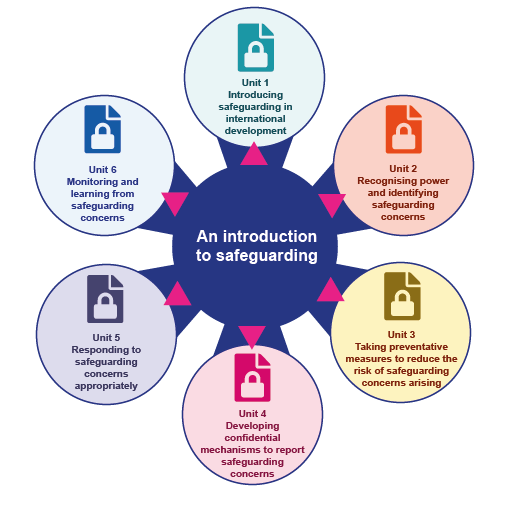Unit 1: Introduction to Safeguarding
| Site: | OpenLearn Create |
| Course: | Introduction to Safeguarding in the International Aid Sector |
| Book: | Unit 1: Introduction to Safeguarding |
| Printed by: | Guest user |
| Date: | Tuesday, 25 November 2025, 3:11 PM |
Table of contents
- Introduction
- 1.1 What’s this course about?
- 1.2 Meet the authors
- 1.3 Learning on this course
- 1.4 Keeping safe: The potential impact of course content
- 1.5 What is safeguarding?
- 1.6 Understanding abuse, neglect and exploitation?
- 1.7 Safeguarding standards in the international development sector
- 1.8 How does your organisation keep people safe?
- 1.9 Unit 1 Knowledge check
- 1.10 Review of Unit 1
Introduction
Welcome to Introduction to Safeguarding in the International Aid Sector.
This is the first course in a series of three safeguarding courses that were first offered on FutureLearn as Mass Open Online Courses (MOOCs). This is why some of the videos you’ll watch on this course refer to these courses as MOOCs.
These MOOCs have been adapted for learning on OpenLearn Create in order to be available for study at any time, in any place and at your pace – thereby providing great flexibility.
Another difference is that on FutureLearn the courses were offered at set presentation times with facilitated forums. On OpenLearn Create the facilitated forums are not available because of the flexibility of start dates that are offered. But some of the discussions and learning from those facilitated forums have been integrated into this OpenLearn Create course through activities and enhanced teaching content.
1.1 What’s this course about?
![]()
Watch the video above in which your lead educator, Aneeta Williams, welcomes you and gives you an overview of what you will be learning about on this course.
Safeguarding children, vulnerable adults and our staff as well as associated personnel is a legal and moral obligation for all those who work in international development agencies.
It has increasingly become an important area of risk for organisations working in the humanitarian and international development sector. It is everyone’s responsibility to safeguard and to prevent, report on and respond to harm that occurs to children, vulnerable adults and staff and associated personnel by putting measures in place to reduce the risk of harm, injury or abuse.
However, several high-profile safeguarding incidents in recent years such as those occurring within Oxfam GB, Save the Children UK, MercyCorps USA and Amnesty International, to name just a few, have highlighted the need for more effective safeguarding systems and processes to prevent and respond to sexual abuse, exploitation, and sexual harassment (SEAH) in the sector.
If you are working in this sector, safeguarding people that you and your organisation have direct or indirect contact with must be given priority. It’s good practice that staff and associated personnel are provided with the opportunity to develop more in-depth knowledge in order to put safeguarding people at the centre of everything that your organisation does.
Organisations should identify a Designated Safeguarding Officer, Safeguarding Lead or Safeguarding Focal Persons so that safeguarding concerns can be reported and responded to appropriately.
This course has been designed for those of you who are new to those positions, and it aims to support you on your journey. It will equip you with the skills and tools you need to play your part in responding to this new and exciting role.
Also, the materials in the course are equally relevant to individuals who may not currently be working in an international organisation but wish to continue refreshing and updating their knowledge and skills.
![]()
By the end of this course, you will be able to:
- Identify the risks associated with those who work for or are engaged with your organisation when they are in contact with others.
- Summarise and explain the different forms of harm, abuse and exploitation, and associated indicators that may be suffered by people with whom your organisation works.
- Use a safeguarding framework based on international standards and donor requirements to improve on safeguarding policies, procedures and practice.
- Support the design of appropriate preventative, reporting and response mechanisms to handle safeguarding concerns.
- Support the development of a safeguarding culture of accountability in your organisation and in communities for safeguarding concerns to be reported and responded to appropriately.
The course should take around 24 learning hours and is divided into 3–4 hours per unit over 6 units (although you can study it at your own pace). The outline of the course content is:

A downloadable version of this diagram is available below.
1.2 Meet the authors
This course has been created by The Open University in partnership with the Foreign, Commonwealth and Development Office (FCDO). The course draws on the experience and expertise of practitioners and academics from within the humanitarian sector.
Meet the authors:
Aneeta Williams is an international human rights lawyer and safeguarding expert in the international aid sector. Aneeta specialises in safeguarding children and vulnerable adults, gender and sexual violence, and human rights and international humanitarian law.
Giles Mohan is a Professor of International Development at The Open University and has developed many courses aimed at professionals working in international development and humanitarianism.
Andy Rixon is a Senior Lecturer in the School of Health, Wellbeing and Social Care at The Open University, specialising in children, young people and families. Andy has a background as a social worker and in social work education.
Emil Dauncey is a Lecturer in International Development at The Open University. As a gender analyst, Emil specialises in global health, sexual and reproductive health, and rights.
1.3 Learning on this course

© Nutthaseth Vanchaichana/ iStock / Getty Images Plus.
How to get the best out of some of the features of this course
Throughout the course, you will come across links to external web pages that navigate you away from this course. It is recommended that you hold down the Ctrl button on your keyboard and click on the link with your mouse to open the web page in a new browser tab.
In this way, you can keep your course open in one tab and view the new content in a separate tab.
The course will also contain learning resources and tools that can be downloaded as you progress that will assist you in learning and implementing the process. You can easily find the tools and templates for each unit under the blue contents bar.
|
Learning journal To enhance your learning, you are asked to keep a learning journal as you progress through this course. This way, you can make notes on:
Your learning journal is personal to you, and it should be useful to you. You may want to share parts of it with a friend or colleague. There are no rules for keeping a learning journal – some days you may write a great deal, and at other times only a little. However, you are advised to write notes in such a way that you can understand them later. This is because we see this course as a starting point for your professional development. There are lots of practical ideas for you to try and we hope you will keep practising the techniques that you learn. In this way, you will have a reference to the things you have learnt even when you are away from a computer. You can keep your journal in a format that appeals to you and is easy for you to maintain – it could be an ordinary paper notebook or on a desktop or mobile device. You may find My Learning Journal useful as a starter document (Word) to record your notes. |
|
Activity 1.1 What do you want to learn from this course? Before you move on to the next step, consider the following questions (this would be a good point to make a start on your learning journal).
|
|
Activity 1.2 What do you already know? It can be helpful to spend some time reflecting on the knowledge and skills you already have on safeguarding. And we would also like to capture your knowledge, expertise and experience before you start this course. This five-minute questionnaire will help you reflect on and evaluate your current situation. All responses are anonymised, so nobody else knows how you have responded. |
1.4 Keeping safe: The potential impact of course content
Trigger warning
The themes and content of the course can inevitably sometimes be disturbing. It is important that you are prepared for this and look after your own welfare, particularly when you watch or listen to the audio and visual material.
Remember:
- Safeguarding is an emotive topic, which may give rise to feelings such as shock, anger or sadness.
- It is important to manage your own feelings in order to free you up to act appropriately – professionally and in the best interests of the child, young person or adult at risk.
- Clarifying your feelings with a peer or professional may help.
- Awareness can bring up painful memories from our own past. Should this be the case, please ensure that you seek support from the resources and support available to you within your organisation or seek professional help.
1.5 What is safeguarding?

© gmast3r / iStock / Getty Images Plus.
A chance to reflect on your reasons for being on the course and develop a community of practice. It introduces safeguarding, what it means to you and to the wider international development sector.
|
What does ‘safeguarding’ mean to you? The word ‘safeguarding’ is about taking an action to prevent harm. The word may not translate well in different languages. Also, it may mean different things dependent on different contexts. Before starting on the next section think about what ‘safeguarding’ mean to you.
|
|
Activity 1.3 Why is safeguarding important to your organisation?
Watch this video in which some Safeguarding Leads in various international organisations working across the world are interviewed. You will hear what they said when they were asked: “Why is safeguarding important to your organisation?” Make a note of the key messages in your learning journal. |
You may be used to ‘safeguarding’ being discussed in relation to protecting children from abuse only. Most countries have enacted laws to protect children and most organisations have relevant policies (whether effective or not) to do the same within their organisation.
However, safeguarding is more than just having a child protection policy. It is important to also think about vulnerable adults who may come into contact with your organisation’s staff, personnel and/or activities. They are made vulnerable because of special characteristics such as their age, sex or sexual orientation, ethnicity, displacement, disability or in need of care and support.
Ultimately, therefore, the aim is to safeguard all persons who come into contact with your organisation, whether directly or indirectly. This includes children (all persons under the age of 18), adults who are made vulnerable due to personal or external circumstances, employees and associated personnel (e.g., volunteers, unpaid Board members, partners, contractors, suppliers).
The responsibility of keeping them safe lies with your organisation and all those who are employed or represent it in any way. Anyone who is in a position of power or authority can misuse that position and cause harm to people with these special characteristics.
The term ‘safeguarding’ is used in this course to mean the measures put in place by the organisation to prevent, report and respond to various forms of harm that could occur through the actions or inactions of your organisation through all activities.
However, you will undoubtedly come across many instances of the abuse of children and adults in the communities in which you work. These too should be recognised as safeguarding concerns and appropriate action taken, including reporting to relevant authorities or advocating for change.
|
Activity 1.4 Sexual exploitation, abuse and sexual harassment (SEAH) The funding for this course has come from the Safeguarding Unit in the UK Foreign, Commonwealth and Development Office’s (FCDO) Safeguarding Unit, whose focus is on tackling sexual exploitation, abuse and sexual harassment (SEAH) in the international aid sector. However, as set out in more detail later, the course covers and is relevant to other forms of harm too. Read this article, What do we mean by safeguarding against SEAH?, which provides a brief definition of safeguarding and SEAH. In your learning journal, make a note of how you would like to describe ‘safeguarding’ for your own organisation. |
1.6 Understanding abuse, neglect and exploitation?
How widespread is abuse, neglect and exploitation?
![]()
Watch the video above where you will meet Hasan, who is a learner on this course.
He is a Human Resources Manager based in Amman, Jordan and he has a question for the lead Educator.
Do you know the prevalence of exploitation, abuse and harassment in your country?
Myths and assumptions made about abuse, exploitation and harassment can actually prevent us from taking the right safeguarding measures.
Our views about who has been harmed and how and why they have been harmed are influenced by our individual or family values, beliefs and the cultural context we have been brought up in or work in.
This can impact on how we view this sensitive and often emotive subject.
|
Activity 1.5 Safeguarding myths and assumptions Next, there are ten
statements – decide whether you think each statement is true or false. |
1.7 Safeguarding standards in the international development sector
Standards for behaviour have been set by the United Nations (UN) since 2003 when it developed the first Code of Conduct in preventing and responding to SEA.
This was in response to safeguarding concerns around the sexual exploitation and abuse of women and children perpetrated by its staff and personnel.
The UN Secretary-General’s Bulletin on the Elimination of Sexual Abuse and Exploitation (known as the UNSG Bulletin) referred to in the following video is still in existence and underpins its Code of Conduct. All organisations who contract with the UN have to abide by the UNSG Bulletin. This bulletin in turn was the basis for the development of the Core Humanitarian Standard.
Several organisations have adopted the prevention of SEA and accountability commitments under the Core Humanitarian Standard. These standards have been endorsed by the international donor community and all organisations and agencies working in the international aid sector. They should form the basis of organisational Codes of Conduct
|
Activity 1.6 How agencies are vulnerable Watch this video (from 0:00 to 03:31 mins) and make a note of some of the key messages in your learning journal. |
1.8 How does your organisation keep people safe?

© AndreyPopov / iStock / Getty Images Plus.
|
Drawing on this unit’s learning content, how does your own agency protect people and how might it improve how it keeps people safe? This might be a point for you to take and discuss with colleagues in your organisation. |
1.9 Unit 1 Knowledge check
The end-of-unit knowledge check is a great way to check your understanding of what you have learnt.
There are five questions, and you can have up to 3 attempts at each question depending on the question type. The quizzes at the end of each unit count towards achieving your Digital Badge for the course. You must score at least 80% in each quiz to achieve the Statement of Participation and Digital Badge.
1.10 Review of Unit 1

© Feodora Chiosea / iStock / Getty Images Plus.
In this first unit of Introduction to Safeguarding in the International Development Sector, you have familiarised yourself with the learning objectives and reflected on your motivations for learning with us.
You have developed an understanding of what the term ‘safeguarding’ means, what are some of the ways that harm can come about and who could be likely perpetrators.
You have also explored the first international standards to come about in the international aid sector.
You have been encouraged to reflect on your own experience, and you have seen how important it is to think about practices within your own organisation that might be in place to keep people safe.
|
Before you move on to Unit 2, we would like you to reflect on and record your own learning experience in your journal by considering the following questions:
In Unit 2, you will be learning more about power and how that misuse of power can cause different forms of harm such as physical, emotional or sexual abuse, exploitation, and harassment. You will also learn how to identify safeguarding concerns that arise. |
Now go to Unit 2: Identify.